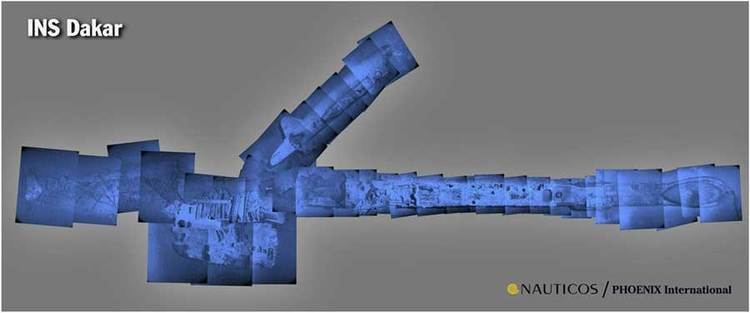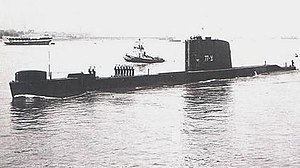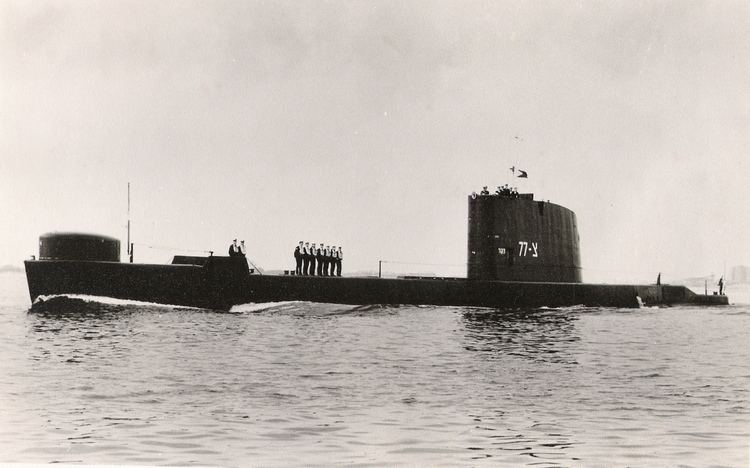Name INS Dakar Laid down 22 October 1942 Commissioned 10 November 1967 Construction started 22 October 1942 Length 84 m Builder HMNB Devonport | Ordered 1941, as HMS Totem Acquired purchased in 1965 Launched 28 September 1943 Beam 7.8 m | |
 | ||
INS Dakar was the former modified British T-class submarine Totem of the Royal Navy. In 1965, she was purchased by Israel as part of a group of three T-class submarines. She was commissioned into the Israeli Sea Corps in November 1967 and underwent sea and diving trials in Scotland. Dakar departed for Israel on 9 January 1968, but disappeared en route with all hands–a total of 69 people. Despite extensive searches over the course of three decades, Dakar's wreckage was not found until 1999, when it was located between the islands of Cyprus and Crete. A portion of the vessel was salvaged and is on display at the Naval Museum in Haifa. The exact cause of Dakar's sinking is not known. It was one of four mysterious submarine disappearances in 1968; the others were those of the French submarine Minerve, the Soviet submarine K-129 and the US submarine USS Scorpion.
Contents
- Early career
- Purchase by Israel
- Voyage to Israel
- Immediate search
- Long term searches and discovery
- Later developments
- In popular culture
- References

Early career

HMS Totem was built to the group 3 variant of the T class design at HM Dockyard Devonport and launched on 28 September 1943. The submarine was completed and commissioned in early 1945. After the end of World War II, Totem and the other surviving group 3 boats were equipped with submarine snorkels to allow longer periods of operation underwater. Between 1951 and 1953, Totem was one of eight boats converted to the "Super T" design, which allowed the vessel higher speed and quieter underwater operation.
Purchase by Israel

In 1965, Totem was purchased by Israel, along with two of her T-class sister boats, Truncheon and Turpin. The former Totem was commissioned into the Israeli Navy on 10 November 1967 as INS Dakar (דקר), (English: Swordfish), under the command of Major Ya'acov Ra'anan.

Dakar left the shipyard for Scotland to conduct her sea and dive trials. Late in 1967, after two successful months of trials, Dakar returned to Portsmouth, England and left for Israel on 9 January 1968.
Voyage to Israel

After leaving England, Dakar put into Gibraltar on the morning of 15 January, departing at midnight, and proceeded across the Mediterranean Sea on snorkel. She reported her position by radio to submarine headquarters in Haifa and was expected to enter her home base on Friday, 2 February, but as she was making excellent time, averaging over eight knots, Ra'anan requested permission to enter port earlier. He was ordered to enter on 29 January. Later, Ra'anan requested to enter a day earlier, on 28 January. This request was denied — the scheduled welcoming ceremony could not be moved.
At 06:10 on 24 January Dakar transmitted her position, 34.16°N 26.26°E, just east of Crete. Over the next 18 hours she sent three control transmissions, which did not include her position, the last at 00:02 25 January 1968. No further transmissions were received.
Immediate search
On 26 January the British Admiralty reported the submarine was missing and gave the last known position as 100 miles (160 km) west of Cyprus. An international search and rescue operation began, including units from Israel, Great Britain, the United States, Greece, Turkey, and Lebanon. Although Haifa Navy radio began broadcasting calls to commercial vessels to be on the look out for the Dakar, Israeli officials would not admit the submarine was missing. On 27 January, a radio station in Nicosia, Cyprus, received a distress call on the frequency of Dakar's emergency buoy, apparently from south-east of Cyprus, but no further traces of the submarine were found. On 31 January, all non-Israeli forces abandoned their search at sunset. Israeli forces continued the search for another four days, giving up at sundown on 4 February 1968.
Israel denied that the Dakar sank as the result of hostile action and stated that the Dakar was involved in crash diving exercises on its return voyage and was lost, probably as a result of a mechanical failure. On 25 April 1968, Vice Admiral Abraham Botzer, commander of the Israeli Navy, stated that the Dakar sank on 24 January 1968, two days before being reported missing, due to "technical or human malfunctioning" and ruled out "foul play".
Long-term searches and discovery
On 9 February 1969, over a year after Dakar went missing, a fisherman found her stern emergency buoy marker washed up on the coast of Khan Yunis, a town southwest of Gaza. British T-class submarines had two such buoy markers, bow and stern, secured behind wooden doors in cages under the deck and attached to the submarine with metal cables 200 meters (650 ft) long. Experts examining the 65 cm (two feet) of cable still attached to the buoy determined that the buoy had remained attached to the submarine for most of the preceding year until the cable broke completely, that Dakar rested in depth between 150 and 326 meters, and that she was 50–70 nmi (93–130 km) off her planned route. All of these determinations were wrong, and misled searchers for decades. It was not until April 1999 and some 25 failed expeditions later that a search effort was concentrated along the path of the original route.
On 1 January 1970, the Egyptian newspaper Al Akhbar reported that the Dakar had been sunk by an Egyptian warship with depth charges. The Egyptian story was told in a 2 July 2005 interview by Asharq Al-Awsat with General Mohamed Azab (major at that time):
On 23 January 1968, the Egyptian frigate, Assyout, left Alexandria base in a training mission for the naval academy. After completing the training assignment and during the return journey to the base; students noticed the periscope of an alien submarine roaming in the Egyptian water, about two miles (3 km) off Alexandria. The Egyptian commander was informed and the decision was taken to attack the unknown submarine. However, the submarine made a very quick and hasty dive and the Egyptian ship lost its trace. General Azab reported the story to his commanders and mentioned that there is a probability that the submarine had crashed into the seabed. However, the story was not believed by the higher Egyptian commanders and there was no sufficient evidence to start a search process. General Azab mentioned that the submarine may have crashed into the seabed due to the shallow depth of water in that region, about 36 meters, while it needed at least 40 meters to dive, however, it appears that the submarine commander decided to take the risk.The Israeli government stated there was no evidence to substantiate the Egyptian unofficial charges.
During the 1980s the Israelis, using a salvage vessel with Egyptian liaison officers, conducted three searches to look for the Dakar in waters north of Sinai and another search off the Greek island of Rhodes. In August 1986, the U.S. Navy committed a P-3 Orion marine reconnaissance and a S-3 anti-submarine warfare aircraft for a search of Egyptian waters near al-Arish. In October 1998, Israel began running advertisements in newspapers in Turkey, Egypt, France, Greece and Russia offering rewards of up to $300,000 for any information on the fate of the Dakar.
On 24 May 1999 a joint U.S.–Israeli search team using information received from U.S. intelligence sources and led by subcontractor Thomas Kent Dettweiler of the American Nauticos Corporation, detected a large body on the seabed between Crete and Cyprus, at a depth of some 3,000 meters (9,800 ft). On 28 May the first video pictures were taken by the remote operated vehicle REMORA II, making it clear that Dakar had been found. She rests on her keel, bow to the northwest. Her conning tower was snapped off and fallen over the side. The stern of the submarine, with the propellers and dive planes, broke off aft of the engine room and rests beside the main hull.
During October 2000 a survey of the Dakar wreckage and the wreckage site was undertaken by Nauticos corporation and the Israeli navy, some artifacts were recovered, including the submarine's bridge, the boat's gyrocompass and many small items.
The exact cause of the loss is unknown, but it appears that no emergency measures had been taken before Dakar dove rapidly through her maximum depth, suffered a catastrophic hull rupture, and continued her plunge to the bottom. The emergency buoy was released by the violence of the hull collapse, and drifted for a year before washing ashore.
Later developments
A memorial designed by architect David Brutzkus was dedicated in 1971 at the National Military and Police cemetery in Mount Herzl in Jerusalem. Various Israeli cities and towns have a Dakar Street, and several schools and other public institutions are also named for the lost submarine. Dakar's bridge and forward edge of her sail are now a memorial display in the Naval Museum in Haifa.
The recovery of any still existing remains of the crew members has been considered. This would permit their Jewish burial in Israel as Judaism does not recognize burial at sea and requires burial in earth. To date crew members' families have held a ceremony in a ship over the submarine's remnants. The Rabbinical authorities had to solve complicated problems of Jewish law before the crew members' wives could be declared officially widows, so that they could remarry.
In 1997 former Israeli Navy captain Michael Eldar published a book titled Dakar, claiming the Israeli search for the submarine had never been serious because officials knew what happened to it. Although it had been cleared for publication by Israel’s military censorship authority the book was banned on national security grounds and copies removed from bookshops. Police raided Eldar's home and confiscated all documents he possessed relating to Dakar.
In the thirty years between the loss of the submarine and the final discovery of its remnants, various suppositions and conspiracy theories circulated, and some members of the public have long believed the crew members to be alive and held in secret captivity in an Arab country or at the Soviet Union.
In 2008, a film was released, entitled Full Circle, a documentary about the search for the wreckage. In May 2009, a book was published by Nauticos president David W. Jourdan entitled, Never Forgotten: The Search and Discovery of Israel's Lost Submarine Dakar. This book chronicles the history of the submarine, the story of the families of the 69 lost sailors, and the events leading to the discovery in 1999.
On 1 September 2015 it was reported that the previously-classified reports on the loss of Dakar and the subsequent search were released to the families of the submarine's crew.
